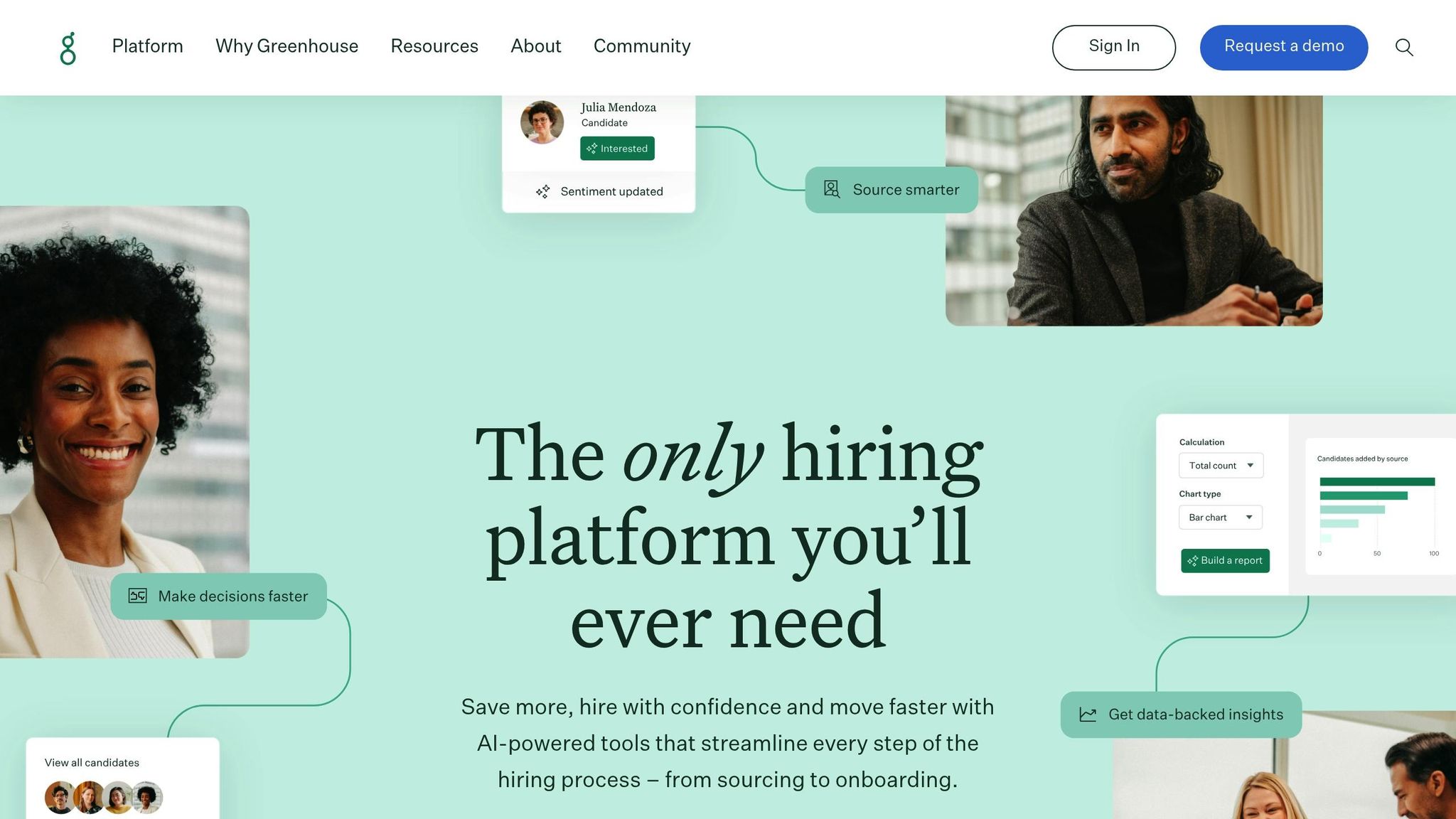Greenhouse Review 2026: A Deep Dive Into Features, Pricing, and Competitors
Greenhouse is a leading applicant tracking system (ATS) in 2026, designed for mid-sized and large businesses focused on efficient, data-driven hiring. Its standout features include structured hiring workflows, DEI tools, and powerful analytics. However, its high cost and learning curve may not suit smaller companies or those with simpler hiring needs.
Key Takeaways:
- Features: Structured interview kits, scorecards, automated scheduling, DEI tools, and onboarding workflows.
- Pricing: Custom quotes; estimated $6,000–$70,000/year depending on company size and features.
- Competitors: Lever, Workable, SmartRecruiters, Teamtailor, and BambooHR.
Greenhouse excels in complex hiring processes but may be overkill for smaller teams or industries like retail and hospitality.
Greenhouse Review: Great for Onboarding, but chill with the emails

What Is Greenhouse?
Greenhouse is an advanced applicant tracking system (ATS) that has been reshaping the way companies approach recruitment since its launch in 2012. Based in New York City, the company supports the hiring efforts of thousands of organizations worldwide, from fast-growing startups to large, established enterprises [2].
The company's mission is straightforward yet ambitious: "to help every company become great at hiring" [1]. This guiding principle highlights Greenhouse's belief that recruiting isn't just an HR task - it’s a strategic capability that can profoundly influence a business's success.
Greenhouse provides more than just a tool for tracking applications. It offers a robust recruitment ecosystem designed to help hiring teams work collaboratively, treat talent acquisition as a fundamental business priority, and adopt fair, unbiased hiring practices. The platform’s features are tailored to streamline internal workflows while also delivering an improved experience for candidates. This dual focus has positively impacted millions of job seekers [1] [3].
By 2026, Greenhouse has established itself as a premium ATS solution, particularly appealing to organizations that treat hiring as a strategic edge rather than a routine administrative task. Its tools are especially well-suited for mid-market and enterprise-level clients managing complex, high-volume recruitment needs. Greenhouse also emphasizes consistency and fairness in hiring, helping companies reduce bias and make more informed decisions.
One satisfied client noted Greenhouse's ability to handle the complexities of enterprise-level hiring, underscoring its effectiveness in meeting the demands of large organizations. Beyond its technical capabilities, Greenhouse is also committed to addressing systemic issues in the job market. The company has created initiatives like MyGreenhouse, which aims to make job searching "a lot less painful – and a lot more fair" for candidates [3].
This strategic approach and dedication to improving the hiring process lay the groundwork for exploring Greenhouse's features in greater detail in the next section.
Greenhouse Features in 2026
Greenhouse continues to evolve as a recruitment platform, shaped by feedback from global hiring practices. Its various modules are designed to tackle specific recruitment challenges while staying true to its core principle: making hiring decisions based on data.
Applicant Tracking and Structured Hiring
At its core, Greenhouse streamlines recruitment with a standardized hiring process. It organizes workflows and creates centralized candidate pipelines, offering full visibility at every stage. These pipelines are highly customizable, allowing businesses to adapt them to their specific hiring needs.
The platform's structured interview kits ensure consistency by equipping interviewers with pre-set questions, evaluation criteria, and scoring systems. This approach minimizes unconscious bias and standardizes how candidates are assessed. Each kit can be tailored for different roles, departments, or levels of seniority.
Using a scorecard system, interviewers rate candidates based on predefined competencies, enabling objective comparisons. This data-driven approach helps hiring managers quickly identify top candidates by reviewing aggregate scores from multiple interview rounds.
To keep the process efficient, Greenhouse automates reminders and team coordination. Notifications for upcoming interviews, missing feedback, and deadlines ensure that promising candidates don’t get overlooked due to communication gaps.
Candidate Sourcing
Greenhouse goes beyond simply posting job ads. Its sourcing tools integrate with major job platforms, creating a unified approach to finding candidates.
With AI-powered search and matching, the platform analyzes candidate profiles against job requirements, considering factors like skills, experience, and career trajectory. This helps recruiters uncover candidates who might not appear in traditional searches, saving time and uncovering hidden talent.
Greenhouse also tackles inclusivity with its diversity-focused sourcing features. Tools like anonymized candidate reviews and bias interruption prompts encourage fair evaluations. Additionally, organizations can track the effectiveness of diverse sourcing channels, helping them build inclusive hiring practices.
The platform simplifies referral management by integrating it directly into the sourcing workflow. Employees can easily recommend candidates, and recruiters can track referral success rates, conversion metrics, and the overall quality of referred talent.
Interview Management
Greenhouse enhances interview management by automating scheduling and centralizing candidate evaluations. Its scheduling automation syncs with popular calendar platforms to find open time slots for interviewers. Candidates can even self-schedule interviews through branded booking links, cutting down on back-and-forth emails.
Interviewer feedback is centralized for consistency. Structured feedback forms guide interviewers through evaluations, while real-time collaboration tools let hiring teams discuss candidates within the platform. Feedback, ratings, and recommendations are all stored in the candidate’s profile for easy reference.
The platform’s analytics provide insights into interview trends, such as scoring patterns and feedback quality. These metrics help organizations identify areas for improvement and address unconscious biases in their evaluation processes.
For remote interviews, Greenhouse integrates with tools like Zoom and Microsoft Teams. Video interviews are seamlessly incorporated, with recordings and notes automatically added to candidate profiles.
Onboarding
Greenhouse’s onboarding module ensures a smooth transition from candidate acceptance to their first day on the job. Customizable workflows cater to different roles, departments, or locations, ensuring a consistent experience for all new hires.
Task management features allow HR teams to assign responsibilities like equipment setup or account creation to specific team members. Automated reminders and progress tracking ensure no steps are missed during onboarding.
The platform also simplifies paperwork with document e-signing integration, supporting popular e-signature tools. This is especially helpful for remote employees who may not have access to printers or scanners.
To keep new hires engaged, the onboarding module includes communication tools. Automated welcome messages, information packets, and pre-boarding surveys help build excitement and gather essential details before the first day.
Reporting and Analytics
Greenhouse turns recruitment data into actionable insights with its reporting and analytics tools. Pre-built dashboards track key metrics like time-to-hire, pipeline conversion rates, and sourcing effectiveness. These dashboards update in real-time, giving hiring teams instant performance insights.
The platform also supports DEI tracking and reporting, helping companies monitor diversity goals while staying compliant with privacy and employment regulations. Hiring velocity analytics highlight bottlenecks in the process, and integration with tools like Tableau and Power BI allows for advanced data analysis.
For organizations with unique needs, Greenhouse offers custom report builders. Users can create specialized reports and schedule automatic deliveries to stakeholders, reinforcing the platform’s focus on data-driven hiring strategies.
User Experience and Interface
Greenhouse offers a sleek, data-packed interface designed to handle even the most intricate hiring workflows with ease.
With its 2026 updates, Greenhouse has made significant strides to simplify candidate pipelines. The refreshed interface minimizes application overload and eliminates the need for disconnected tools, making it easier for recruiting teams to identify top talent effortlessly [4].
The updated Greenhouse Analytics takes things up a notch, allowing every team member to query, filter, and create reports from hiring data without needing help from analysts or external tools [4]. These changes make it easier than ever to make informed, data-backed decisions.
AI tools like Real Talent™ and Talent Match further refine the hiring process by cutting through digital clutter and filtering out low-quality applications [4]. This lets HR teams zero in on the most promising candidates quickly and effectively.
Interview scheduling has also gotten a major upgrade. With AI-driven interviewer matching, real-time panel replacements, and automatic conflict checks, scheduling is now faster and more efficient. Features like customized self-scheduling pages and pre-made email templates make the process even smoother [4].
Onboarding has been enhanced with dynamic plans that automatically coordinate tasks and sync in real-time with HRIS platforms like ADP, BambooHR, and Workday [4]. This eliminates the hassle of manual data entry and ensures workflows are seamless, cutting down on duplicate data management across systems.
Greenhouse Pricing in 2026
Greenhouse uses a custom, quote-based pricing model, meaning pricing details aren’t openly listed. To get an accurate cost estimate, potential customers need to request a demo and work directly with the sales team for a tailored quote.
Pricing Structure and Tiers
Greenhouse offers three main pricing tiers: Essential, Advanced, and Expert. Each plan builds on the previous one, adding more features as you move up. The cost varies depending on factors like company size, hiring volume, and the specific modules you need. Industry estimates suggest smaller teams typically pay between $6,000 and $10,000 per year, while larger organizations might see costs climb to $70,000 annually [5].
Additional Costs and Add-Ons
In addition to the core ATS platform, Greenhouse offers premium features and modules for an extra fee. These add-ons can include:
- Onboarding tools to simplify new hire processes
- Sourcing automation for finding top candidates
- HRIS Link for seamless system integration
- Advanced features, such as texting (via Grayscale), sandbox sync, and audit logs (included in the Expert plan)
- Custom integrations designed to fit your company's tech stack
These extras can significantly impact the final price, so it’s crucial to review all potential costs during your demo.
Free Demos
Though Greenhouse doesn’t provide free trials, they do offer free demos. These sessions allow companies to discuss their hiring needs, explore features, and receive a personalized quote.
Cost Considerations
Breaking down Greenhouse’s pricing helps clarify the potential costs. For example, basic packages often start around $18,000, but prices can rise sharply with higher-tier plans and additional features. Companies willing to commit to longer contracts might be able to negotiate better rates. Greenhouse’s pricing reflects its enterprise-level features, extensive integrations, and comprehensive functionality, making it a strong option for businesses with complex hiring needs.
sbb-itb-88a7fe6
Pros and Cons of Greenhouse
When considering Greenhouse as your applicant tracking system (ATS), it’s essential to weigh its benefits against the potential hurdles it might bring. While Greenhouse is packed with powerful, data-focused tools, implementing it can demand significant changes to your existing hiring processes [6]. Here's a closer look at the strengths and challenges of adopting Greenhouse.
Pros
- Structured, data-focused hiring: Helps reduce bias and improves the quality of hiring decisions.
- Extensive integration options: Compatible with over 400 partner tools and platforms.
- Enterprise-level reporting and analytics: Offers in-depth insights into hiring performance.
- Focus on DEI (Diversity, Equity, and Inclusion): Includes tools for diversity tracking and bias reduction.
- Scalable for global companies: Designed to meet the needs of large, distributed organizations.
- Streamlined interview management: Features like automated scheduling and feedback collection simplify the process.
- Comprehensive compliance tools: Includes GDPR, SOC 2, and EEO compliance features.
- AI-driven sourcing tools: Enhances candidate discovery and matching.
Cons
- High cost: The premium pricing may deter smaller organizations.
- Learning curve: Requires extensive staff training to maximize its potential.
- Challenging implementation: Tasks like integrating existing job boards and migrating legacy data can be time-consuming [6].
- Advanced features tied to pricing tiers: Some reporting tools are only accessible at higher price points.
- Limited customization: Not ideal for non-standard or highly tailored workflows.
- Longer deployment time: Full system adoption can take longer than expected [6].
- Resource-heavy setup: Demands significant time and personnel during the initial implementation phase.
Comparison Table: Pros and Cons
| Pros | Cons |
|---|---|
| Data-focused, structured hiring | High pricing structure |
| Over 400 integrations available | Steep learning curve |
| Enterprise-grade analytics | Complex implementation process |
| Strong DEI tools | Limited customization for workflows |
| Scalable for large organizations | Longer deployment timeline |
| Advanced compliance features | Resource-intensive setup |
Customer Support and Onboarding
Getting started with Greenhouse is more than just signing a contract - it’s about ensuring a smooth transition from your current systems to a powerful hiring platform. Greenhouse offers multiple support channels and a structured onboarding process to help organizations hit the ground running.
Once you’re set up, the level of support you receive depends on your plan. If you’re on the Essential or Advanced plan, you’ll typically have access to standard email and live chat support. However, Expert tier clients and larger enterprises enjoy additional perks like priority support and a dedicated account manager for personalized guidance.
The onboarding process usually takes about 4 to 8 weeks. That said, if your organization has more complex needs - like handling large volumes of historical data, managing multiple integrations, or setting up custom workflows - it might take a bit longer.
Here’s what onboarding typically looks like:
- Kickoff Meeting: A dedicated specialist works with your team to outline the implementation plan.
- Data Migration: Candidate records, job postings, and interview feedback are transferred with field mapping and custom scripts to minimize any downtime.
- System Configuration: Your hiring workflows are tailored to fit your organization’s needs.
- Training: Comprehensive sessions ensure your HR teams and hiring managers are ready to use the platform effectively.
Training is available in a variety of formats, including live webinars, on-demand video tutorials, and interactive help guides. For enterprise clients, Greenhouse goes the extra mile by offering tailored workshops and training sessions to ensure your team is fully equipped from day one.
User feedback highlights the importance of the support tier you choose. Reviews on sites like G2, Capterra, and TrustRadius often commend the knowledgeable and responsive support team. Enterprise users, in particular, appreciate having a dedicated account manager, while some lower-tier users have reported longer response times or delays with more complex technical issues.
Support doesn’t stop after onboarding. Greenhouse continues to assist through its help desk, live chat, and account management teams. Enterprise clients also gain access to a priority support queue and regular check-ins, including quarterly business reviews, to address their evolving needs.
For those who prefer to troubleshoot independently, Greenhouse provides a robust online knowledge base. It’s packed with step-by-step guides, FAQs, troubleshooting tips, release notes, and product update webinars - giving users the tools they need to solve common issues and stay updated on new features.
It’s worth noting that onboarding services might come with additional costs depending on your plan and company size. Make sure to clarify what’s included and any extra charges during the sales process to avoid surprises.
Greenhouse’s structured onboarding and ongoing support are designed to make adoption as smooth as possible, setting your organization up for long-term success in hiring.
Greenhouse Competitors
Greenhouse has carved out a strong reputation for its structured hiring approach and data-driven recruitment tools. However, the ATS market in 2026 is filled with alternatives, each bringing its own strengths to the table. While these platforms offer unique features, none fully replicate Greenhouse's emphasis on structured processes and analytics.
Other ATS Platforms
Lever takes a proactive stance on recruitment by blending ATS features with CRM capabilities through its LeverTRM suite. It’s a great option for companies focused on talent pooling, automated nurture campaigns, and building detailed candidate profiles for long-term engagement. Lever also provides pipeline health reporting and integrates with over 300 applications - though that’s fewer than Greenhouse’s 500+ pre-built integrations[9][13].
Workable is a favorite among small to medium-sized businesses, thanks to its all-in-one hiring platform. Its intuitive design streamlines hiring with one-click job postings across hundreds of job boards and AI-powered candidate sourcing and matching. Workable integrates with approximately 270 to 290 applications, making it easy to implement and use[9][11][13].
SmartRecruiters focuses on recruitment marketing and collaborative hiring. It offers an open marketplace for third-party recruitment services and includes candidate relationship management tools. However, its setup process can be lengthy due to complex configurations, and its filtering system may feel less intuitive compared to Greenhouse’s user-friendly interface[10][14].
Teamtailor stands out for its emphasis on employer branding and enhancing the candidate experience, making it a top choice for companies prioritizing recruitment marketing. Similarly, BambooHR's ATS module appeals to organizations that want an integrated HR and recruiting solution, particularly small and medium-sized businesses seeking a comprehensive people management tool.
While these platforms shine in specific areas, Greenhouse continues to lead the pack with its structured interview kits, advanced analytics, and customizable features that drive data-backed hiring decisions. Its focus on reducing bias and optimizing the recruitment process sets it apart from the competition[9][10][12].
Who Should Use Greenhouse in 2026?
When it comes to hiring software in 2026, Greenhouse stands out for mid-market and enterprise companies that prioritize structured, data-driven recruitment processes. If your organization is scaling quickly and hiring more than 50 people annually, Greenhouse's automation tools, structured interviews, and detailed reporting can be a game-changer - especially for HR teams dedicated to improving efficiency and outcomes.
Greenhouse is also a strong choice for companies focused on diversity hiring goals. Its built-in DEI tools and bias-reduction features help ensure fair, objective decision-making during the hiring process. Additionally, businesses that rely on complex workflows will appreciate Greenhouse's extensive API support and its network of 500+ integrations, which make it easier to connect with other tools in your tech stack.
That said, Greenhouse isn’t a perfect fit for everyone. For small startups or businesses with simpler hiring needs, the platform’s advanced features might feel like overkill, both in terms of cost and complexity [15][9]. Similarly, companies without dedicated IT resources could struggle with setup and customization [15].
Industries like retail and hospitality, which often focus on high-volume, low-skill hiring, may find Greenhouse’s sophisticated features unnecessary. These sectors typically benefit more from streamlined hiring processes than from the detailed analytics and structured interviews Greenhouse emphasizes [15]. Poor configuration during implementation can also lead to workflow challenges, making careful planning essential [16].
For organizations looking for all-in-one HR platforms, Greenhouse might fall short. Its primary focus is recruitment, so it doesn’t cover areas like payroll or benefits administration [15].
Ultimately, Greenhouse is best suited for data-driven companies that want to continuously refine their hiring strategies. If your leadership team values metrics like time-to-hire, source effectiveness, or interviewer performance, Greenhouse’s analytics tools can provide the insights needed to make evidence-based decisions and improve hiring outcomes over time.
Conclusion
Greenhouse continues to stand out as a top choice for data-driven recruiting teams in 2026, thanks to its well-rounded feature set, strategic pricing, and strong market presence. Its standout capability lies in its structured hiring process - offering customizable workflows, interview kits, and scorecards that bring consistency and reduce bias across hiring practices.
What truly sets Greenhouse apart is its robust analytics and reporting tools. The platform provides detailed dashboards that track critical metrics like time-to-hire, conversion rates, and diversity, equity, and inclusion (DEI) progress. It also integrates seamlessly with business intelligence tools and allows data exports for deeper analysis. According to reviews on platforms like G2 and Capterra, many large organizations have seen measurable improvements. For instance, a U.S.-based tech company reported a 30% reduction in time-to-hire and improved DEI outcomes after leveraging Greenhouse’s structured workflows and analytics capabilities [7].
Greenhouse’s commitment to DEI is another highlight. Features like anonymized candidate views, DEI-specific reports, and behavioral nudges enable companies to meet compliance standards and advance diversity goals - an increasingly important consideration for U.S. businesses aiming to build equitable hiring practices.
That said, Greenhouse does have its challenges. Its premium pricing can be a hurdle for smaller businesses, and the platform’s extensive feature set comes with a steeper learning curve compared to simpler applicant tracking systems (ATS). Additionally, some of its advanced analytics and integrations are only accessible through higher-tier plans, which may limit flexibility for organizations with unique workflows [8].
Even with these limitations, Greenhouse delivers strong value for mid-sized and enterprise organizations aiming to optimize and scale their recruiting efforts. With consistently high ratings - 4.4/5 on G2, 4.5/5 on Capterra, and 8.6/10 on TrustRadius - and recognition from industry leaders like Gartner and HR Tech Outlook, the platform has earned its reputation among thousands of enterprise clients worldwide [7].
For HR leaders considering Greenhouse in 2026, the platform’s investment in both cost and implementation effort is well worth it. It delivers better hiring outcomes, reduces bias, and provides actionable insights that help teams continuously improve. If structured, data-driven recruitment is a priority and your organization has the resources to support it, Greenhouse remains one of the strongest ATS options on the market today.
FAQs
What are the key advantages of using Greenhouse for data-driven hiring in 2026?
Greenhouse stands out as a valuable resource for data-driven hiring in 2026, offering HR teams tools to refine and elevate their recruitment strategies. With its advanced analytics and reporting features, teams can monitor essential metrics like source effectiveness, candidate engagement, and time-to-hire. This approach not only highlights areas needing improvement but also streamlines the hiring process for better efficiency.
On top of that, Greenhouse emphasizes structured hiring with tools such as customizable workflows, interview scorecards, and DEI-focused features. These functionalities help create a more equitable process by minimizing bias, promoting fairness, and ensuring hiring practices align with broader organizational objectives.
How does Greenhouse help companies improve diversity, equity, and inclusion (DEI) in hiring?
Greenhouse equips organizations with tools to promote diversity, equity, and inclusion (DEI) in hiring by focusing on fairer, more inclusive processes. Key features include structured interview kits that help reduce bias, anonymized candidate views to prioritize qualifications over personal details, and diversity-focused sourcing tools to expand talent pools.
The platform also offers DEI analytics, enabling companies to assess hiring bias and monitor engagement. These insights help businesses pinpoint areas needing improvement and make informed, data-backed decisions. Together, these tools help companies create more diverse and inclusive teams.
How can companies determine if Greenhouse is the right ATS for their hiring needs?
To figure out if Greenhouse is the right ATS for your business, think about your company’s size, hiring needs, and how much value you place on structured, data-driven recruitment. Greenhouse works best for mid-sized to large companies that emphasize diversity, equity, and inclusion (DEI), rely on advanced analytics, and need smooth integrations with other tools. That said, its higher price point and steeper learning curve might make it less appealing for smaller teams or startups operating on tighter budgets.
Consider whether your organization requires features like customizable workflows, compliance tools, or the ability to scale hiring processes effectively. Greenhouse is built for companies aiming to grow while maintaining fair, structured, and scalable recruitment strategies.
Related Blog Posts
Read also
Ready to get started?
If you want to dive into the details just Book a Free Consultation with our staff and we’ll be happy to answer your questions.





